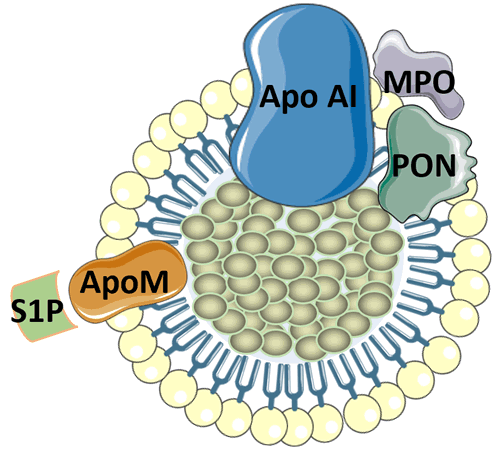Metabolic changes in maternal body during pregnancy substantially arose due to the need to ensure an adequate growth of the fetus. Development of pregnancy complications, such as gestational diabetes, gestational hypertension, preeclampsia, preterm birth and fetal growth restriction have multiple underlying mechanisms, but all closely related to disorders of maternal metabolism. Lipid profile alterations during pregnancy are common and well studied, but changes in structure and function of high density lipoprotein (HDL) are still insufficiently explored in this physiological condition.
HDL is the smallest lipoprotein in plasma with the main role to transport the excess cholesterol from peripheral tissues to the liver, which accounts for its cardioprotective function. However, the role of HDL goes far beyond its cholesterol content. HDL particles are composed of more than 100 different proteins, cholesterol, non-cholesterol sterols, glycerophospholipids, triglycerides and other lipid compounds, which indicate many distinctive physiological functions of this lipoprotein.

|
HDL particles alterations have already been identified as important features in many different pathophysiological conditions, especially in cardiovascular disease. In contrast, structural and functional changes of HDL are seldom investigated in pregnancy, whereas the associations of HDL lipidome, proteome and functionality (HDL-ome) with the pregnancy outcome and later cardiometabolic health of woman and child are almost completely unexplored.
The main objective of HI-MOM project is to determine the pattern of changes in women’s HDL-ome during pregnancy and to link specific HDL-ome alterations with different pregnancy outcomes. We will track and map longitudinal changes in women’s HDL-ome during the course of uncomplicated and high-risk pregnancy. Based on the observed specific HDL-ome changes and identified HDL-ome biomarkers, we will design panels of multi-marker analyses for early recognition of risk for potential pregnancy complications and related outcomes.
Special attention of HI-MOM project is given to the assessment of metabolic and genetic origin of structure-function modifications of HDL in pregnancy and its possible effects on pregnancy outcome. The ambition of HI-MOM project is also to explore the association between specific, pregnancy-induced HDL-ome changes and neonatal characteristics. This research will significantly contribute to better understanding of long-lasting effects of pregnancy-induced metabolic alterations on maternal and child cardiometabolic health.